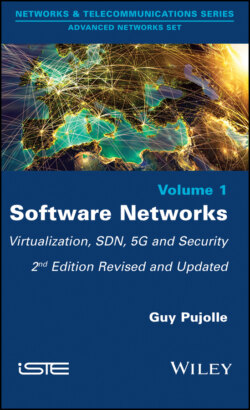Читать книгу Software Networks - Guy Pujolle - Страница 11
I.1. The first two revolutions
ОглавлениеA circuit is a collection of hardware and software elements, allocated to two users – one at each end of the circuit. The resources of that circuit belong exclusively to those two users; nobody else can use them. In particular, this mode has been used in the context of the public switched telephone network (PSTN). Indeed, telephone voice communication is a continuous application for which circuits are very appropriate.
A major change in traffic patterns brought about the first great revolution in the world of networks, pertaining to asynchronous and non-uniform applications. The data transported for these applications make only very incomplete use of circuits, but are appropriate for packet-switched mode. When a message needs to be sent from a transmitter to a receiver, the data for transmission are grouped together in one or more packets, depending on the total size of the message. For a short message, a single packet may be sufficient; however, for a long message, several packets are needed. The packets then pass through intermediate transfer nodes between the transmitter and the receiver, and ultimately make their way to the endpoint. The resources needed to handle the packets include memories, links between the nodes and sender/receiver. These resources are shared between all users. Packet-switched mode requires a physical architecture and protocols – i.e. rules – to achieve end-to-end communication. Many different architectural arrangements have been proposed, using protocol layers and associated algorithms. In the early days, each hardware manufacturer had their own architecture (e.g. SNA, DNA, DecNet, etc.). Then, the OSI (Open System Interconnection) model was introduced in an attempt to make all these different architectures mutually compatible. The failure of compatibility between hardware manufacturers, even with a common model, led to the re-adoption of one of the very first architectures introduced for packet-switched mode: TCP/IP (Transport Control Protocol/Internet Protocol).
The second revolution was the switch from hardwired mode to wireless mode. Figure I.1 shows that, by 2020, terminal connection should be essentially wireless, established using Wi-Fi technology, including 3G/4G/5G technology. In fact, increasingly, the two techniques are used together, as they are becoming mutually complimentary rather than representing competition for one another. In addition, when we look at the curve shown in Figure I.2, plotting worldwide user demand against the growth of what 3G/4G/5G technology is capable of delivering, we see that the gap is so significant that only Wi-Fi technology is capable of handling the demand very strongly until 2020, and then less and less due to the massive opening of new frequencies, especially those higher than 20 GHz. We will come back to wireless architectures, because the third revolution also has a significant impact on this transition towards radio-based technologies, especially 5G technology.
Figure I.1. Terminal connection by 2020
Figure I.2. The gap between technological progress and user demand. For a color version of the figure, see www.iste.co.uk/pujolle/software2.zip
